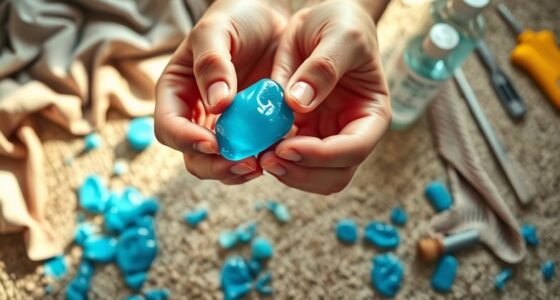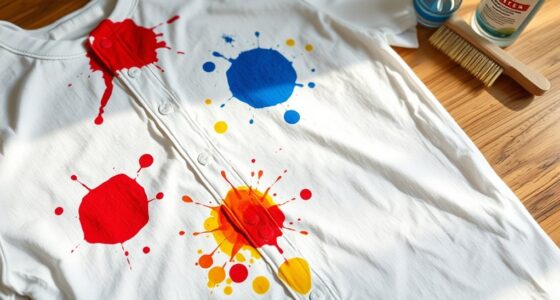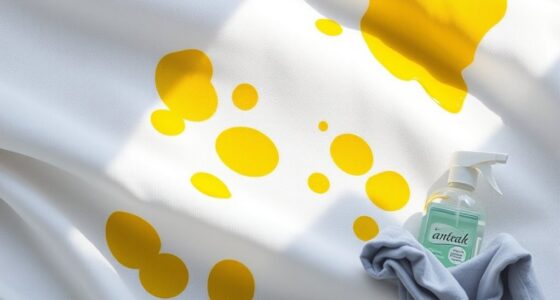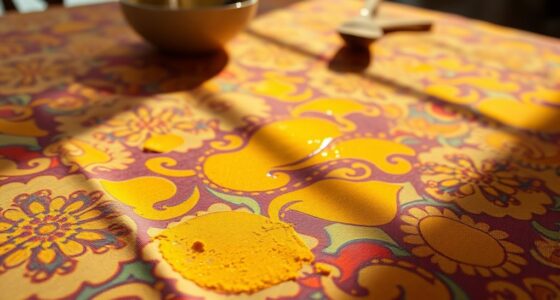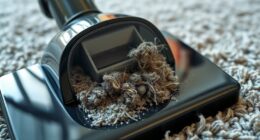To eliminate mold and mildew stains from fabrics easily, start by identifying any visible signs like discoloration or musty smells. Pre-treat stains with a mix of white vinegar and water or use diluted borax for delicate fabrics. Clean with natural solutions such as hydrogen peroxide or baking soda. For tough stains, consider commercial stain removers. To protect your fabrics, store them in dry, ventilated spaces. Want to know more about effective techniques and long-term care? Keep on exploring!
Key Takeaways
- Pre-treat stains with a mixture of equal parts white vinegar and water to effectively combat mold and mildew.
- Use hydrogen peroxide for tough stains by applying it directly and letting it sit for 15 minutes before rinsing.
- Wash fabrics with baking soda added to the cycle for deodorization and mold removal enhancement.
- For delicate fabrics, consider lemon juice mixed with salt or diluted borax as a gentle cleaning solution.
- If stains persist, seek professional cleaning services to avoid damaging treasured or complex fabrics.
Identifying Signs of Mold and Mildew on Fabrics

How can you tell if your fabrics are suffering from mold or mildew?
First, look for visible signs like powdery white or gray patches, which indicate mildew. If you spot darker, black, or green spots, that’s mold. Both can give fabrics a fuzzy texture or cause unusual discoloration.
Pay attention to any musty smells, as this odor often accompanies mold growth. Additionally, consider the type of fabric; natural fibers like cotton and linen are more vulnerable. Regular inspections can help ensure that you are maintaining ideal humidity levels to prevent mold and mildew growth.
If you notice any skin irritation or allergy symptoms after handling your fabrics, it might be time to take action.
Regularly inspecting your storage areas for moisture and poor ventilation can help you catch these issues early.
Essential Pre-Treatment and Safety Measures

Before tackling mold and mildew stains on your fabrics, it’s important to take essential pre-treatment steps and safety measures.
Start by applying a mixture of equal parts white vinegar and water to the stained area, or dilute borax as per package instructions. For delicate fabrics, use a combination of lemon juice and salt. If the stains are tough, consider a commercial mold remover like Iosso. Mold thrives in damp conditions, making it crucial to address any moisture issues in your storage areas.
Always wear gloves and a mask to protect yourself from spores, and isolate moldy items to prevent spreading. Confirm good ventilation during the process and avoid shaking the fabrics vigorously.
Effective Natural Cleaning Solutions

While tackling mold and mildew stains on fabrics, you’ll find that effective natural cleaning solutions can be both safe and powerful.
Start with white distilled vinegar; its acidity kills mold effectively. Mix equal parts water and vinegar in a spray bottle and apply to the stains. Inhaling mold spores may cause allergic reactions, so always wear a mask when cleaning. Using vinegar not only helps eliminate mold but also improves color reproduction, ensuring your fabrics look their best.
Start by using white distilled vinegar; its natural acidity effectively eliminates mold stains when mixed with water and sprayed directly onto the fabric.
Hydrogen peroxide is another excellent option; let it sit on the fabric for 15 minutes before rinsing.
Baking soda acts as a deodorizer and can be added to the wash cycle to freshen your clothes.
For added antibacterial properties, use lemon juice directly on stains or in the laundry.
Finally, consider essential oils like tea tree or lavender oil, which not only combat mold but also leave a pleasant scent.
Chemical and Commercial Products for Stain Removal

Natural cleaning solutions can effectively tackle mold and mildew stains, but sometimes you need the power of chemical and commercial products for tougher challenges.
Chlorine bleach works well on some fabrics, but be cautious; it can damage fibers and colors. Consider sodium perborate bleach as a safer alternative. For mildew stain removal, petroleum distillates or hydrocarbon-based products can be effective.
Commercially, CLR Mold & Mildew Stain Remover is a bleach-free option that works on fabrics. Clorox Tilex is effective on non-porous surfaces but harmful to fabrics. Always test a hidden area first, wear gloves, and avoid mixing products.
For severe cases, professional cleaning services may be your best bet to guarantee safe and effective stain removal.
Preventive Measures to Protect Fabrics From Mildew

Taking proactive steps can greatly reduce the risk of mildew forming on your fabrics. Start by regularly cleaning your fabrics to prevent dirt buildup, which can attract moisture. Store your items in dry, well-ventilated spaces to keep humidity levels low. Consider using dehumidifiers or moisture-absorbing materials to maintain a dry environment. Maintaining relative humidity below 70% is crucial to inhibit mildew growth.
When selecting fabrics, opt for mildew-resistant options, especially if you’re dealing with cotton or linen. Additionally, make certain your storage areas are organized and clutter-free to prevent moisture accumulation in hidden spots. Regularly check your fabrics for any signs of mildew, and take prompt action if you notice any issues. With these measures, you’ll keep your fabrics safe and fresh.
Special Care for Different Fabric Types

When it comes to caring for your fabrics, understanding their specific needs is vital to prevent mold and mildew growth. Natural fibers like cotton and linen absorb moisture quickly, making them prone to mold. Wool and silk can also be affected in high humidity, especially when exposed to high relative humidity. In contrast, synthetic fibers like polyester resist mold due to their lower moisture absorption. For delicate fabrics, use spot treatments like lemon juice and salt, and opt for enzyme-based mold removers. Always test treatments on a small area first. Outdoor fabrics should be cleaned regularly and stored in well-ventilated spaces to minimize moisture.
Techniques for Removing Mold and Mildew Stains

To effectively tackle mold and mildew stains on fabrics, you’ll want to start with some essential techniques that can make a significant difference.
Begin by using a soft brush to gently remove visible spores, preventing them from spreading. If possible, take the fabric outdoors and shake it to remove loose spores.
For tougher stains, spray a mixture of equal parts vinegar and water directly on the affected area. You can also pre-soak in a borax solution for stubborn mold. Additionally, consider using Clorox® Bleach for bleach-safe fabrics to enhance stain removal.
After cleaning, air dry the fabric thoroughly to stop further growth. Finally, consider using a HEPA-filtered vacuum to eliminate any remaining residues.
These techniques will help you effectively combat mold and mildew stains on your fabrics.
Proper Washing and Drying Methods

Although mold and mildew stains can be stubborn, using proper washing and drying methods can greatly improve your chances of eliminating them.
Start by brushing off visible mold spores to prevent spreading during the wash. Check fabric care labels for washing temperature and test any cleaning solutions on a hidden area first.
For white fabrics, chlorine bleach effectively removes stains, while Clorox 2 for Colors is safer for colored items. Adding vinegar can help eliminate odors without damage. Regular cleaning of fabrics is also essential to prevent mold growth in the first place, as it supports a healthier lifestyle by promoting cleanliness and hygiene.
When drying, air dry your fabric to prevent moisture buildup, and hang it in sunlight for natural disinfection. Inspect for remaining stains post-dry and repeat the process if needed.
Good ventilation is key to preventing mold from returning.
Long-Term Fabric Storage Tips

Proper washing and drying methods set the stage for effective long-term fabric storage.
Store your fabrics in a cool, dry place to keep moisture at bay. Avoid basements or attics with high humidity, and guarantee good air circulation to prevent mildew.
Use breathable garment bags or plastic bins with ventilation, steering clear of cardboard boxes. Keep fabrics out of direct sunlight to avoid fading.
Organize similar fabrics together and label containers for easy access. Regularly vacuum the storage area and check for musty odors or mildew signs.
Consider cedar-lined containers to deter pests and use scented sachets for freshness.
With these tips, your fabrics will remain in great condition for years to come.
When to Seek Professional Help for Stain Removal

Wondering when it’s time to call in the professionals for stain removal?
If you’re dealing with delicate fabrics like silk or antique items, it’s best to let experts handle the stains.
Complex stains, such as mold or grease, often require specialized equipment and techniques that you mightn’t have access to. Certain stains can be more difficult to eliminate, making expert intervention crucial.
Professionals achieve results that home remedies can’t always deliver, preventing further damage to your fabrics.
If a stain has deeply penetrated or spread considerably, prompt professional intervention is key.
They’ve the tools to safely test for colorfastness and use advanced cleaning solutions tailored to your fabric type.
Don’t risk permanent damage—sometimes, expert help is the safest choice for your treasured items.
Frequently Asked Questions
Can I Use Vinegar on All Types of Fabric?
You can’t use vinegar on all types of fabric without caution.
While it’s generally safe for cotton and outdoor fabrics, you should be careful with delicate materials. Always test vinegar on a hidden area first to avoid any damage.
It’s not recommended for acid-dyed fabrics unless done correctly.
Remember to dilute it to protect fabric fibers and avoid using it with bleach, as that can cause harm.
How Can I Tell if Mold Is Dead After Cleaning?
Imagine a garden where the flowers wilt but still hold memories of their bloom.
To know if mold’s withered, look for the powdery flakes that brush off surfaces easily.
But beware—just like the garden’s remnants, dead mold can still stir up allergies. A lab test is the surest way to confirm its status.
Always remember, whether it’s alive or dead, mold’s presence can still affect your well-being.
Do I Need to Wash Fabrics After Using Bleach?
Yes, you need to wash fabrics after using bleach. This step helps remove any remaining bleach residue, ensuring your fabrics are clean and safe to use.
Always wash them in the appropriate water temperature according to the care label—hot for whites, cold for colors.
Avoid overloading the washer, so everything gets rinsed thoroughly. This way, you prevent any potential damage or discoloration in your fabrics while keeping them fresh.
Can Sunlight Damage Certain Fabrics While Removing Mildew?
Imagine your favorite shirt basking in sunlight like a sunbather on a beach; it’s invigorating yet risky.
Yes, sunlight can damage certain fabrics while removing mildew. Natural fibers like cotton and delicate materials such as silk are particularly vulnerable, losing color and strength under UV rays.
To protect your fabrics, limit their exposure and consider using alternative methods like vinegar or professional cleaning for a safer approach to mildew removal.
What Are the Signs of Mildew Growth in Stored Fabrics?
When you store fabrics, watch for signs of mildew growth. You might notice a musty odor, which often signals dampness.
Look for visible mildew, appearing as a powdery white or gray substance on the fabric. Fungal spots in various colors and any discoloration indicate potential mildew issues.
If you feel the fibers weakening, it’s a clear sign that mildew is affecting your stored items, so addressing these signs promptly is essential.
Conclusion
Just like a gardener tending to a wilting flower, you can nurture your fabrics back to life by banishing mold and mildew. With the right tools and techniques, you’ll transform your stained treasures into vibrant pieces once again. Remember, prevention is your best ally, keeping your fabrics safe from nature’s unwelcome intruders. So, roll up your sleeves, embrace the journey, and let your fabrics bloom beautifully in your home’s garden of comfort.


